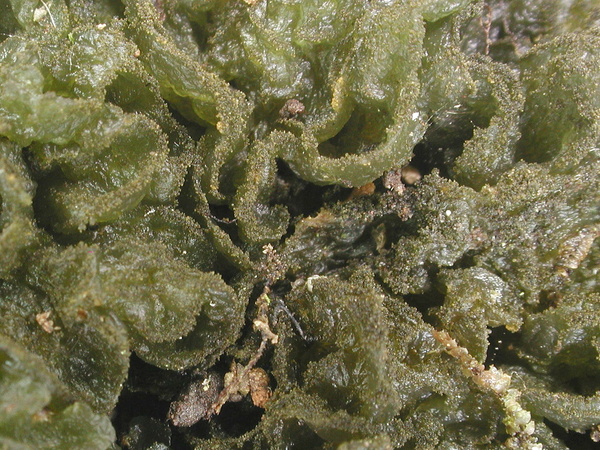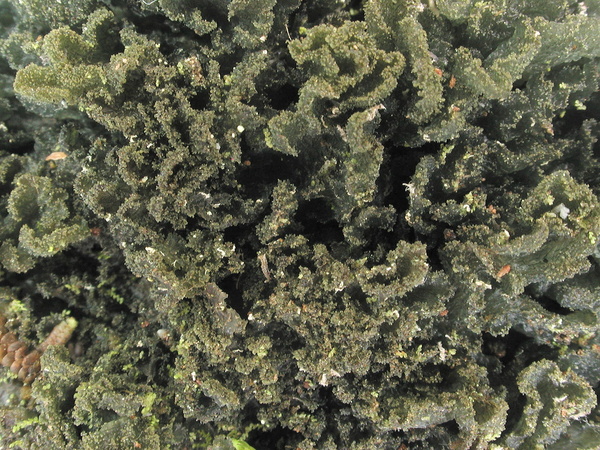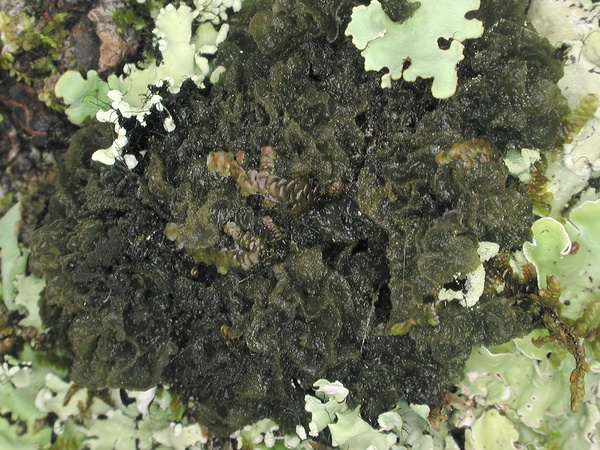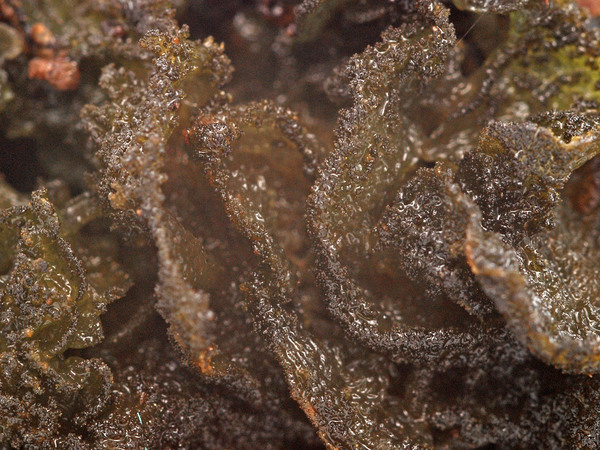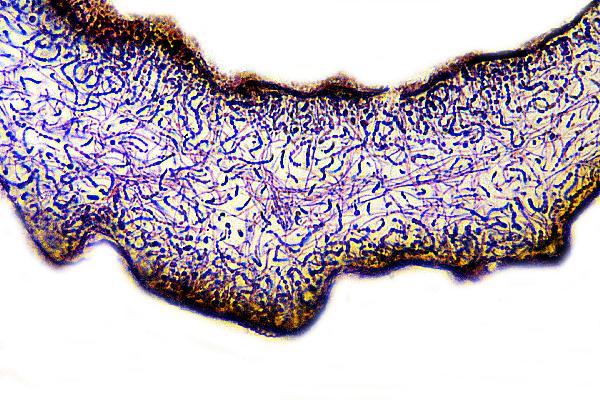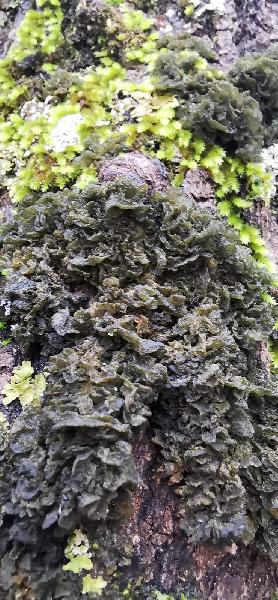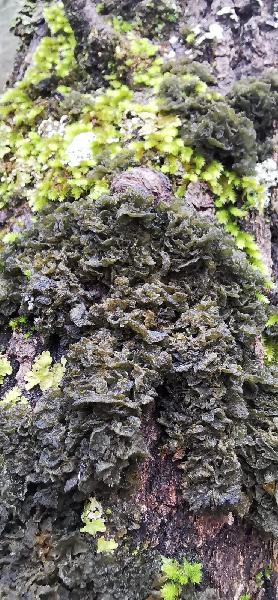Leptogium brebissonii Mont.
in Webb & Berthelot, Hist. Nat. Iles Canar., 3, 2: 130, 1840.
Synonyms: Leptogium chloromelum auct. ital. p.p. non (Ach.) Nyl.; Leptogium ruginosum (Dufour ex Schaer) Nyl.; Synechoblastus ruginosus (Dufour) Hepp
Distribution: N - Lig. C - Tosc (Putortì & Loppi 1999b), Umb (Ravera 2000, Ravera & al. 2006), Laz (Ravera 2001, Massari & Ravera 2002, Ravera & Genovesi 2008), Abr (Recchia & Villa 1996, Caporale & al. 2016), Mol (Ravera & Genovesi 2012, Genovesi & Ravera 2014, Paoli & al. 2015), Sar (Zedda 2002). S - Camp (Nimis & Tretiach 2004, Garofalo & al. 2010, Ravera & Brunialti 2013), Bas (Bartoli & Puntillo 1996, 1998, Potenza 2006), Cal (Puntillo 1996, Puntillo & Puntillo 2004), Si.
Description: Thallus foliose, strongly swollen and gelatinous when wet, loosely attached, isidiate, blue-grey to lead-grey when dry, dark green-grey when wet, 3-5 cm wide. Lobes poorly differentiated, 5-20 mm wide, markedly wrinkled and radially ridged, sometimes fenestrate, with dark grey to brown-black (darker than thallus), granular to subcylindrical isidia developing along the margins and on the ridges, finally spreading through the entire surface; lower surface paler, rugose, without tomentum. Upper and lower cortices composed of a single layer of angular cells; inner part of thallus with loosely interwoven chains of Nostoc and hyphae. Apothecia extremely rare, lecanorine, with a reddish brown disc and a rugose, often isidiate thalline margin. Epithecium brown; hymenium and hypothecium colourless. Ascospores 3-septate, hyaline, narrowly fusiform to acicular, 40-65 x 3-8 μm. Photobiont cyanobacterial (Nostoc, the cells in long chains). Spot tests: all negative. Chemistry: without lichen substances.Note: described from the Canary Islands, this is a mild-temperate to humid subtropical, typically western-Tyrrhenian species in Italy, most frequent in open, humid woodlands, especially in old coastal plantations of Olea. According to Kaasalainen & al. (2021), molecular data suggest that in the Tropics it can be subdivided into at least four closely related, but morphologically different species.
Growth form: Foliose, broad lobed
Substrata: bark
Photobiont: cyanobacteria, filamentous (e.g. Nostoc, Scytonema)
Reproductive strategy: mainly asexual, by isidia, or isidia-like structures (e.g. schizidia)
Most common in areas with a humid-warm climate (e.g. most of Tyrrenian Italy)
Commonnes-rarity: (info)
Alpine belt: absent
Subalpine belt: absent
Oromediterranean belt: absent
Montane belt: absent
Submediterranean belt: extremely rare
Padanian area: absent
Humid submediterranean belt: very rare
Humid mediterranean belt: rare
Dry mediterranean belt: absent
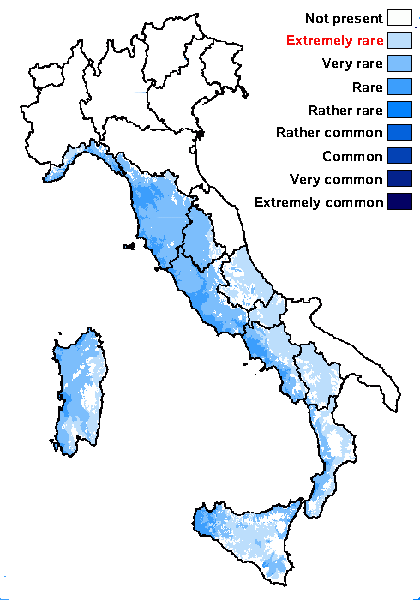
Predictive model
Herbarium samples
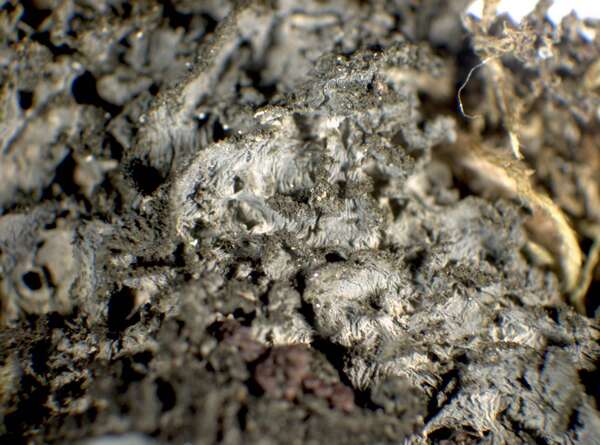

P.L. Nimis; Owner: Department of Life Sciences, University of Trieste
Herbarium: TSB (13906)
2001/12/08
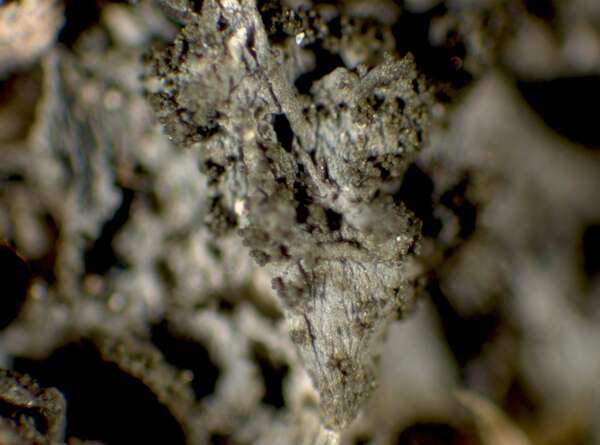

P.L. Nimis; Owner: Department of Life Sciences, University of Trieste
Herbarium: TSB (13906)
2001/12/08
wrinkled upper surface with isidia
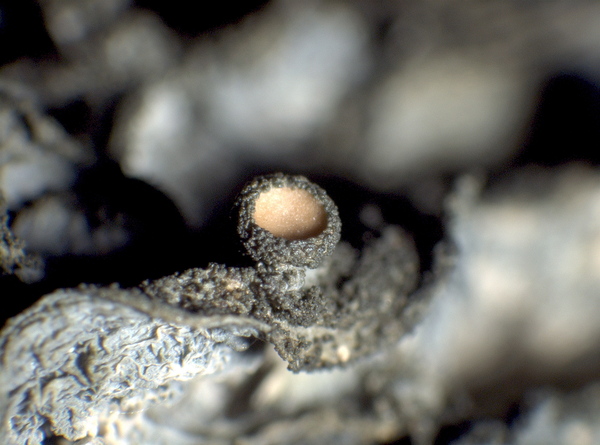

E. Pittao; Owner: Department of Life Sciences, University of Trieste
Herbarium: TSB (13908)
2008.03.10
apothecium
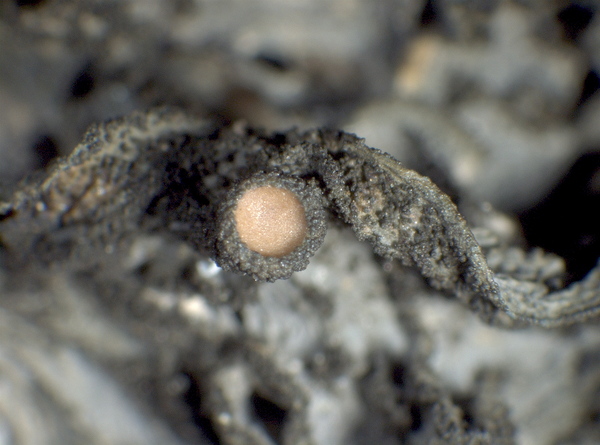

E. Pittao; Owner: Department of Life Sciences, University of Trieste
Herbarium: TSB (13908)
2008.03.10
apothecium
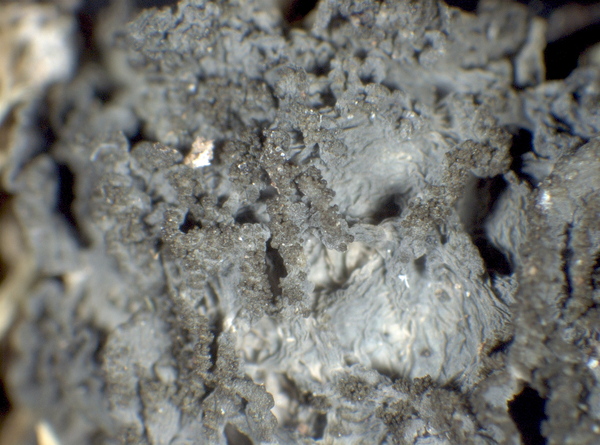

E. Pittao; Owner: Department of Life Sciences, University of Trieste
Herbarium: TSB (13908)
2008.03.10
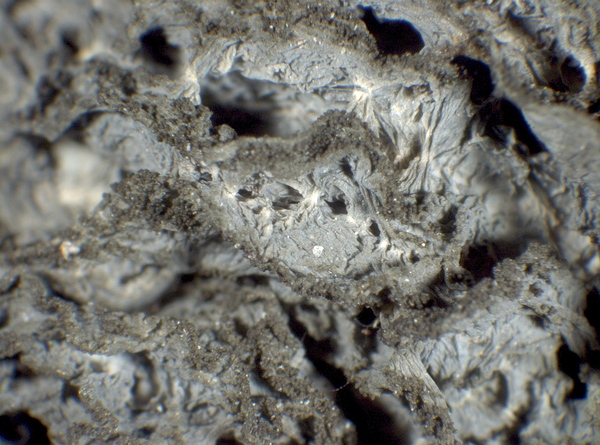

E. Pittao; Owner: Department of Life Sciences, University of Trieste
Herbarium: TSB (13908)
2008.03.10
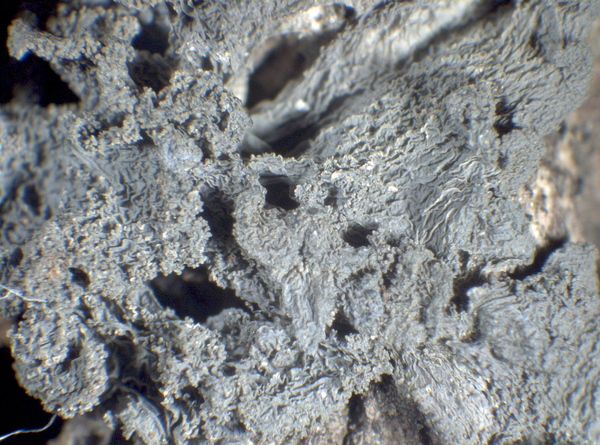

E. Pittao; Owner: Department of Life Sciences, University of Trieste
Herbarium: TSB (23295)
2008.03.10
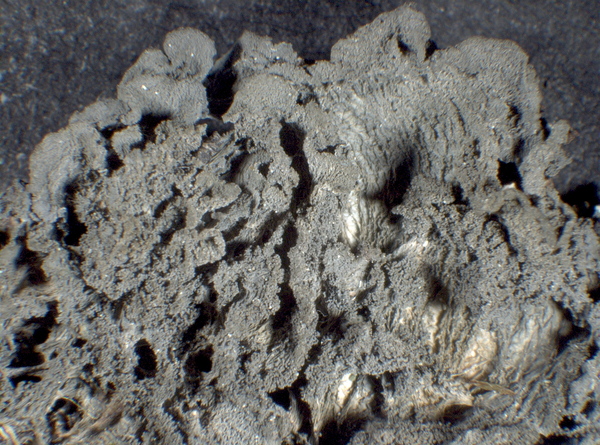

E. Pittao; Owner: Department of Life Sciences, University of Trieste
Herbarium: TSB (31980)
2008.03.10
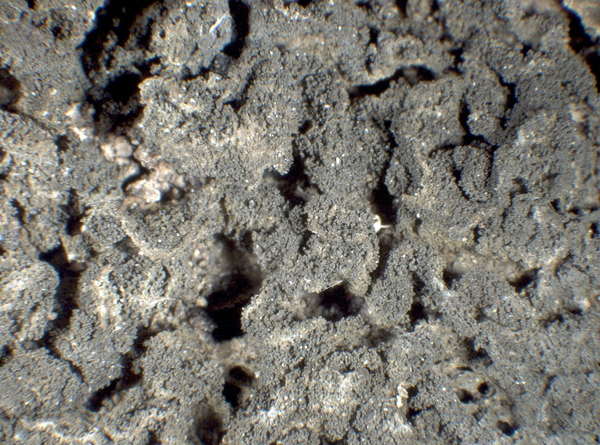

E. Pittao; Owner: Department of Life Sciences, University of Trieste
Herbarium: TSB (31980)
2008.03.10
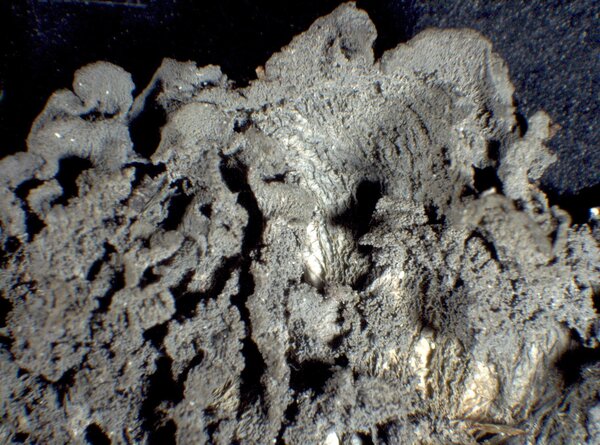

E. Pittao; Owner: Department of Life Sciences, University of Trieste
Herbarium: TSB (31980)
2008.03.10
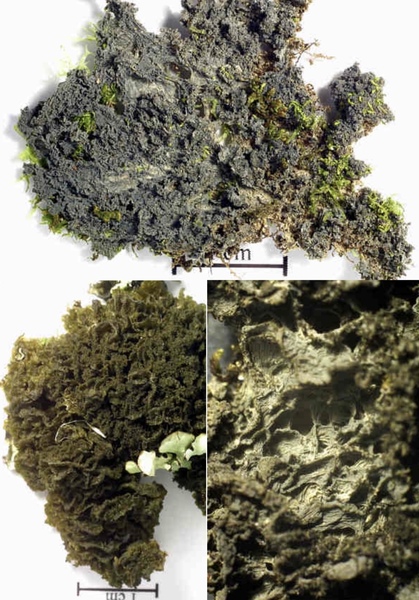

Felix Schumm – CC BY-SA 4.0
Image from: F. Schumm (2008) - Flechten Madeiras, der Kanaren und Azoren. Beck, OHG - ISBN: 978-3-00-023700-3


Felix Schumm - CC BY-SA 4.0
[11001], Portugal, Azoren, Sao Miguel: Südufer des Lagoa das Furnas,
270 m, 37°45.022' N, 25°19.807' W. Leg. F. Schumm, 03.06.2003, det.
F. Schumm, 07.2003. - Rinde zellig; Isiden; extrem stark faltig.
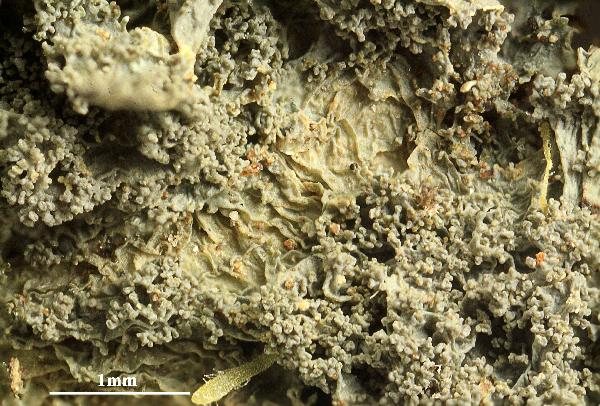

Felix Schumm - CC BY-SA 4.0
[11001], Portugal, Azoren, Sao Miguel: Südufer des Lagoa das Furnas,
270 m, 37°45.022' N, 25°19.807' W. Leg. F. Schumm, 03.06.2003, det.
F. Schumm, 07.2003. - Rinde zellig; Isiden; extrem stark faltig.
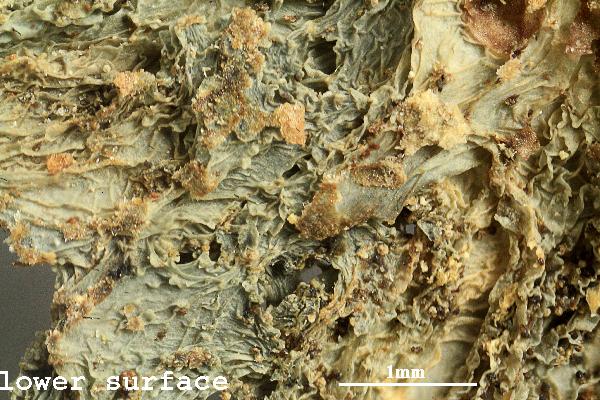

Felix Schumm - CC BY-SA 4.0
[11001], Portugal, Azoren, Sao Miguel: Südufer des Lagoa das Furnas,
270 m, 37°45.022' N, 25°19.807' W. Leg. F. Schumm, 03.06.2003, det.
F. Schumm, 07.2003. - Rinde zellig; Isiden; extrem stark faltig.


Felix Schumm - CC BY-SA 4.0
[11001], Portugal, Azoren, Sao Miguel: Südufer des Lagoa das Furnas,
270 m, 37°45.022' N, 25°19.807' W. Leg. F. Schumm, 03.06.2003, det.
F. Schumm, 07.2003. - Rinde zellig; Isiden; extrem stark faltig.


Felix Schumm - CC BY-SA 4.0
[11001], Portugal, Azoren, Sao Miguel: Südufer des Lagoa das Furnas,
270 m, 37°45.022' N, 25°19.807' W. Leg. F. Schumm, 03.06.2003, det.
F. Schumm, 07.2003. - Rinde zellig; Isiden; extrem stark faltig.
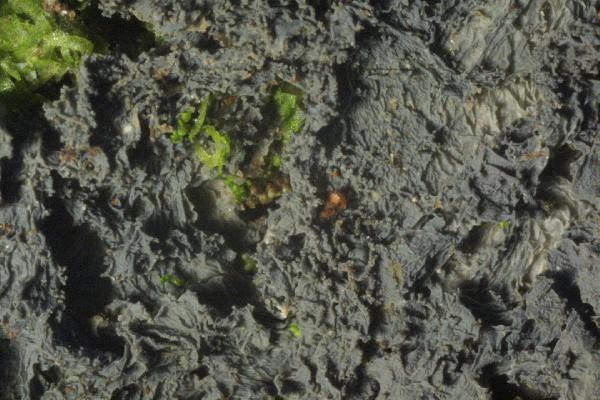

Felix Schumm - CC BY-SA 4.0
[11001], Portugal, Azoren, Sao Miguel: Südufer des Lagoa das Furnas,
270 m, 37°45.022' N, 25°19.807' W. Leg. F. Schumm, 03.06.2003, det.
F. Schumm, 07.2003. - Rinde zellig; Isiden; extrem stark faltig.


Felix Schumm - CC BY-SA 4.0
[11001], Portugal, Azoren, Sao Miguel: Südufer des Lagoa das Furnas,
270 m, 37°45.022' N, 25°19.807' W. Leg. F. Schumm, 03.06.2003, det.
F. Schumm, 07.2003. - Rinde zellig; Isiden; extrem stark faltig.
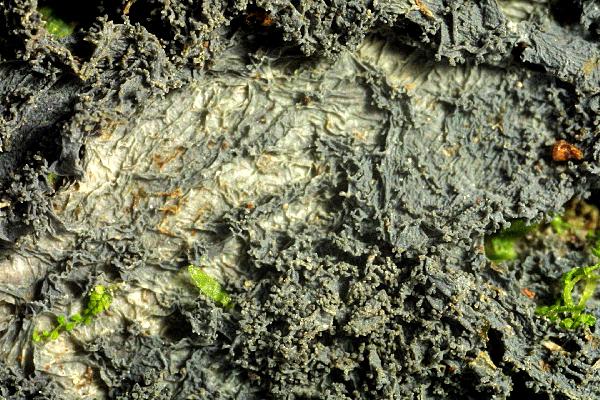

Felix Schumm - CC BY-SA 4.0
[11001], Portugal, Azoren, Sao Miguel: Südufer des Lagoa das Furnas,
270 m, 37°45.022' N, 25°19.807' W. Leg. F. Schumm, 03.06.2003, det.
F. Schumm, 07.2003. - Rinde zellig; Isiden; extrem stark faltig.


Felix Schumm - CC BY-SA 4.0
[10785], Portugal, Azoren, Sao Miguel: Südufer des Lagoa das Furnas,
270 m, 37°45.022' N, 25°19.807' W. Leg. F. Schumm, 03.06.2003, det.
F. Schumm 07.2003. -Mit kleinzelliger, einschichtiger Rinde, Zellen
5,5 μm; Nostoc, 3,3 μm.
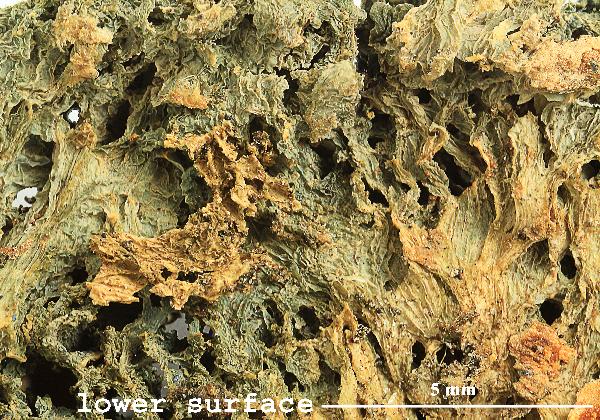

Felix Schumm - CC BY-SA 4.0
[10785], Portugal, Azoren, Sao Miguel: Südufer des Lagoa das Furnas,
270 m, 37°45.022' N, 25°19.807' W. Leg. F. Schumm, 03.06.2003, det.
F. Schumm 07.2003. -Mit kleinzelliger, einschichtiger Rinde, Zellen
5,5 μm; Nostoc, 3,3 μm.


Felix Schumm - CC BY-SA 4.0
[10785], Portugal, Azoren, Sao Miguel: Südufer des Lagoa das Furnas,
270 m, 37°45.022' N, 25°19.807' W. Leg. F. Schumm, 03.06.2003, det.
F. Schumm 07.2003. -Mit kleinzelliger, einschichtiger Rinde, Zellen
5,5 μm; Nostoc, 3,3 μm.
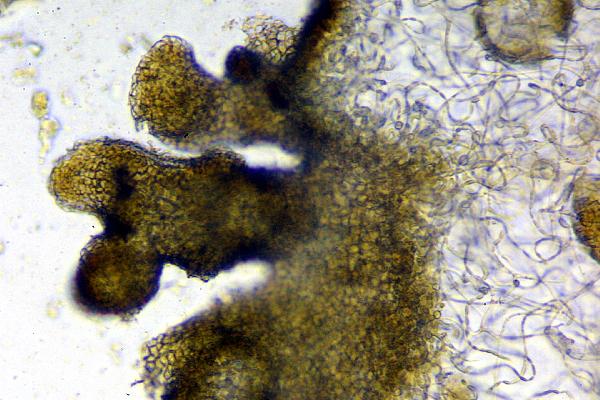

Felix Schumm - CC BY-SA 4.0
[10785], Portugal, Azoren, Sao Miguel: Südufer des Lagoa das Furnas,
270 m, 37°45.022' N, 25°19.807' W. Leg. F. Schumm, 03.06.2003, det.
F. Schumm 07.2003. -Mit kleinzelliger, einschichtiger Rinde, Zellen
5,5 μm; Nostoc, 3,3 μm.
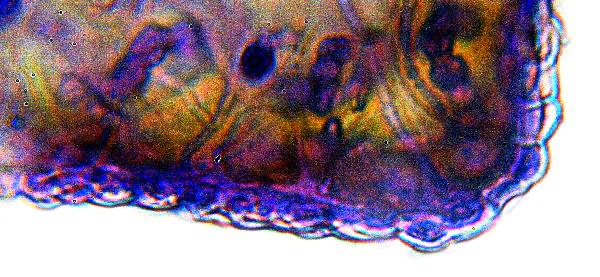

Felix Schumm - CC BY-SA 4.0
[10785], Portugal, Azoren, Sao Miguel: Südufer des Lagoa das Furnas,
270 m, 37°45.022' N, 25°19.807' W. Leg. F. Schumm, 03.06.2003, det.
F. Schumm 07.2003. -Mit kleinzelliger, einschichtiger Rinde, Zellen
5,5 μm; Nostoc, 3,3 μm.
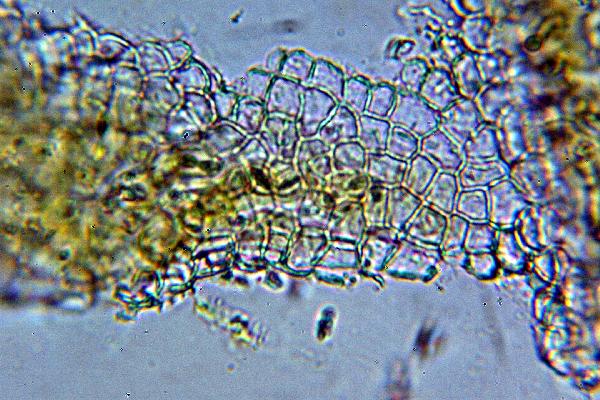

Felix Schumm - CC BY-SA 4.0
[10785], Portugal, Azoren, Sao Miguel: Südufer des Lagoa das Furnas,
270 m, 37°45.022' N, 25°19.807' W. Leg. F. Schumm, 03.06.2003, det.
F. Schumm 07.2003. -Mit kleinzelliger, einschichtiger Rinde, Zellen
5,5 μm; Nostoc, 3,3 μm.
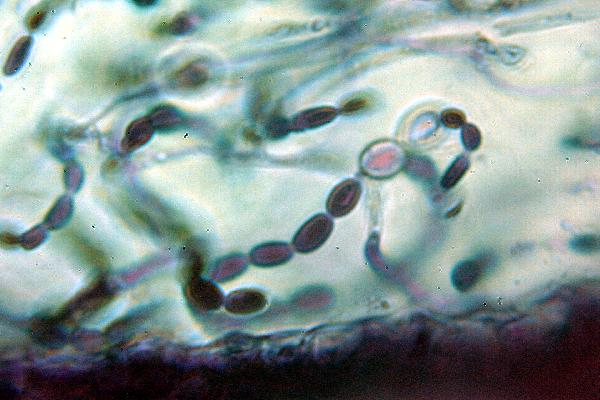

Felix Schumm - CC BY-SA 4.0
[10785], Portugal, Azoren, Sao Miguel: Südufer des Lagoa das Furnas,
270 m, 37°45.022' N, 25°19.807' W. Leg. F. Schumm, 03.06.2003, det.
F. Schumm 07.2003. -Mit kleinzelliger, einschichtiger Rinde, Zellen
5,5 μm; Nostoc, 3,3 μm.


Felix Schumm - CC BY-SA 4.0
[10785], Portugal, Azoren, Sao Miguel: Südufer des Lagoa das Furnas,
270 m, 37°45.022' N, 25°19.807' W. Leg. F. Schumm, 03.06.2003, det.
F. Schumm 07.2003. -Mit kleinzelliger, einschichtiger Rinde, Zellen
5,5 μm; Nostoc, 3,3 μm.


Felix Schumm - CC BY-SA 4.0
[10785], Portugal, Azoren, Sao Miguel: Südufer des Lagoa das Furnas,
270 m, 37°45.022' N, 25°19.807' W. Leg. F. Schumm, 03.06.2003, det.
F. Schumm 07.2003. -Mit kleinzelliger, einschichtiger Rinde, Zellen
5,5 μm; Nostoc, 3,3 μm.
Growth form: Foliose, broad lobed
Substrata: bark
Photobiont: cyanobacteria, filamentous (e.g. Nostoc, Scytonema)
Reproductive strategy: mainly asexual, by isidia, or isidia-like structures (e.g. schizidia)
Most common in areas with a humid-warm climate (e.g. most of Tyrrenian Italy)
Commonnes-rarity: (info)
Alpine belt: absent
Subalpine belt: absent
Oromediterranean belt: absent
Montane belt: absent
Submediterranean belt: extremely rare
Padanian area: absent
Humid submediterranean belt: very rare
Humid mediterranean belt: rare
Dry mediterranean belt: absent

Predictive model
| Herbarium samples |


P.L. Nimis; Owner: Department of Life Sciences, University of Trieste
Herbarium: TSB (13906)
2001/12/08


P.L. Nimis; Owner: Department of Life Sciences, University of Trieste
Herbarium: TSB (13906)
2001/12/08
wrinkled upper surface with isidia


E. Pittao; Owner: Department of Life Sciences, University of Trieste
Herbarium: TSB (13908)
2008.03.10
apothecium


E. Pittao; Owner: Department of Life Sciences, University of Trieste
Herbarium: TSB (13908)
2008.03.10
apothecium


E. Pittao; Owner: Department of Life Sciences, University of Trieste
Herbarium: TSB (13908)
2008.03.10


E. Pittao; Owner: Department of Life Sciences, University of Trieste
Herbarium: TSB (13908)
2008.03.10


E. Pittao; Owner: Department of Life Sciences, University of Trieste
Herbarium: TSB (23295)
2008.03.10


E. Pittao; Owner: Department of Life Sciences, University of Trieste
Herbarium: TSB (31980)
2008.03.10


E. Pittao; Owner: Department of Life Sciences, University of Trieste
Herbarium: TSB (31980)
2008.03.10


E. Pittao; Owner: Department of Life Sciences, University of Trieste
Herbarium: TSB (31980)
2008.03.10


Felix Schumm – CC BY-SA 4.0
Image from: F. Schumm (2008) - Flechten Madeiras, der Kanaren und Azoren. Beck, OHG - ISBN: 978-3-00-023700-3


Felix Schumm - CC BY-SA 4.0
[11001], Portugal, Azoren, Sao Miguel: Südufer des Lagoa das Furnas, 270 m, 37°45.022' N, 25°19.807' W. Leg. F. Schumm, 03.06.2003, det. F. Schumm, 07.2003. - Rinde zellig; Isiden; extrem stark faltig.


Felix Schumm - CC BY-SA 4.0
[11001], Portugal, Azoren, Sao Miguel: Südufer des Lagoa das Furnas, 270 m, 37°45.022' N, 25°19.807' W. Leg. F. Schumm, 03.06.2003, det. F. Schumm, 07.2003. - Rinde zellig; Isiden; extrem stark faltig.


Felix Schumm - CC BY-SA 4.0
[11001], Portugal, Azoren, Sao Miguel: Südufer des Lagoa das Furnas, 270 m, 37°45.022' N, 25°19.807' W. Leg. F. Schumm, 03.06.2003, det. F. Schumm, 07.2003. - Rinde zellig; Isiden; extrem stark faltig.


Felix Schumm - CC BY-SA 4.0
[11001], Portugal, Azoren, Sao Miguel: Südufer des Lagoa das Furnas, 270 m, 37°45.022' N, 25°19.807' W. Leg. F. Schumm, 03.06.2003, det. F. Schumm, 07.2003. - Rinde zellig; Isiden; extrem stark faltig.


Felix Schumm - CC BY-SA 4.0
[11001], Portugal, Azoren, Sao Miguel: Südufer des Lagoa das Furnas, 270 m, 37°45.022' N, 25°19.807' W. Leg. F. Schumm, 03.06.2003, det. F. Schumm, 07.2003. - Rinde zellig; Isiden; extrem stark faltig.


Felix Schumm - CC BY-SA 4.0
[11001], Portugal, Azoren, Sao Miguel: Südufer des Lagoa das Furnas, 270 m, 37°45.022' N, 25°19.807' W. Leg. F. Schumm, 03.06.2003, det. F. Schumm, 07.2003. - Rinde zellig; Isiden; extrem stark faltig.


Felix Schumm - CC BY-SA 4.0
[11001], Portugal, Azoren, Sao Miguel: Südufer des Lagoa das Furnas, 270 m, 37°45.022' N, 25°19.807' W. Leg. F. Schumm, 03.06.2003, det. F. Schumm, 07.2003. - Rinde zellig; Isiden; extrem stark faltig.


Felix Schumm - CC BY-SA 4.0
[11001], Portugal, Azoren, Sao Miguel: Südufer des Lagoa das Furnas, 270 m, 37°45.022' N, 25°19.807' W. Leg. F. Schumm, 03.06.2003, det. F. Schumm, 07.2003. - Rinde zellig; Isiden; extrem stark faltig.


Felix Schumm - CC BY-SA 4.0
[10785], Portugal, Azoren, Sao Miguel: Südufer des Lagoa das Furnas, 270 m, 37°45.022' N, 25°19.807' W. Leg. F. Schumm, 03.06.2003, det. F. Schumm 07.2003. -Mit kleinzelliger, einschichtiger Rinde, Zellen 5,5 μm; Nostoc, 3,3 μm.


Felix Schumm - CC BY-SA 4.0
[10785], Portugal, Azoren, Sao Miguel: Südufer des Lagoa das Furnas, 270 m, 37°45.022' N, 25°19.807' W. Leg. F. Schumm, 03.06.2003, det. F. Schumm 07.2003. -Mit kleinzelliger, einschichtiger Rinde, Zellen 5,5 μm; Nostoc, 3,3 μm.


Felix Schumm - CC BY-SA 4.0
[10785], Portugal, Azoren, Sao Miguel: Südufer des Lagoa das Furnas, 270 m, 37°45.022' N, 25°19.807' W. Leg. F. Schumm, 03.06.2003, det. F. Schumm 07.2003. -Mit kleinzelliger, einschichtiger Rinde, Zellen 5,5 μm; Nostoc, 3,3 μm.


Felix Schumm - CC BY-SA 4.0
[10785], Portugal, Azoren, Sao Miguel: Südufer des Lagoa das Furnas, 270 m, 37°45.022' N, 25°19.807' W. Leg. F. Schumm, 03.06.2003, det. F. Schumm 07.2003. -Mit kleinzelliger, einschichtiger Rinde, Zellen 5,5 μm; Nostoc, 3,3 μm.


Felix Schumm - CC BY-SA 4.0
[10785], Portugal, Azoren, Sao Miguel: Südufer des Lagoa das Furnas, 270 m, 37°45.022' N, 25°19.807' W. Leg. F. Schumm, 03.06.2003, det. F. Schumm 07.2003. -Mit kleinzelliger, einschichtiger Rinde, Zellen 5,5 μm; Nostoc, 3,3 μm.


Felix Schumm - CC BY-SA 4.0
[10785], Portugal, Azoren, Sao Miguel: Südufer des Lagoa das Furnas, 270 m, 37°45.022' N, 25°19.807' W. Leg. F. Schumm, 03.06.2003, det. F. Schumm 07.2003. -Mit kleinzelliger, einschichtiger Rinde, Zellen 5,5 μm; Nostoc, 3,3 μm.


Felix Schumm - CC BY-SA 4.0
[10785], Portugal, Azoren, Sao Miguel: Südufer des Lagoa das Furnas, 270 m, 37°45.022' N, 25°19.807' W. Leg. F. Schumm, 03.06.2003, det. F. Schumm 07.2003. -Mit kleinzelliger, einschichtiger Rinde, Zellen 5,5 μm; Nostoc, 3,3 μm.


Felix Schumm - CC BY-SA 4.0
[10785], Portugal, Azoren, Sao Miguel: Südufer des Lagoa das Furnas, 270 m, 37°45.022' N, 25°19.807' W. Leg. F. Schumm, 03.06.2003, det. F. Schumm 07.2003. -Mit kleinzelliger, einschichtiger Rinde, Zellen 5,5 μm; Nostoc, 3,3 μm.


 Index Fungorum
Index Fungorum
 GBIF
GBIF

